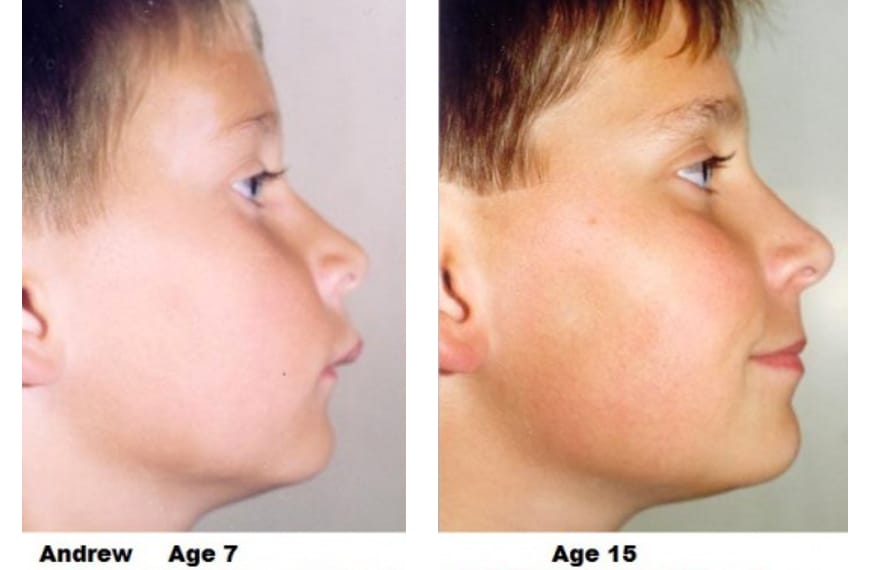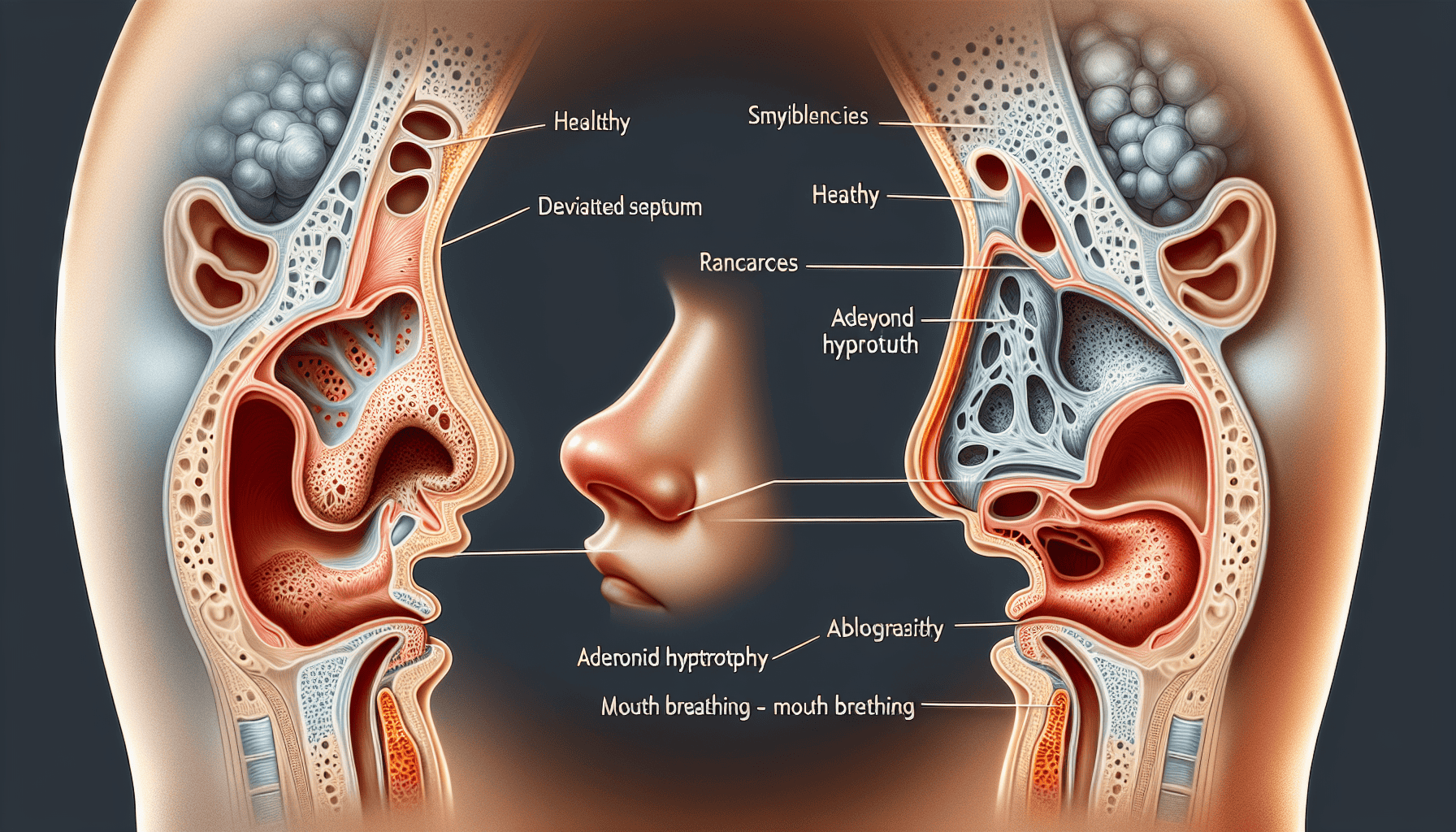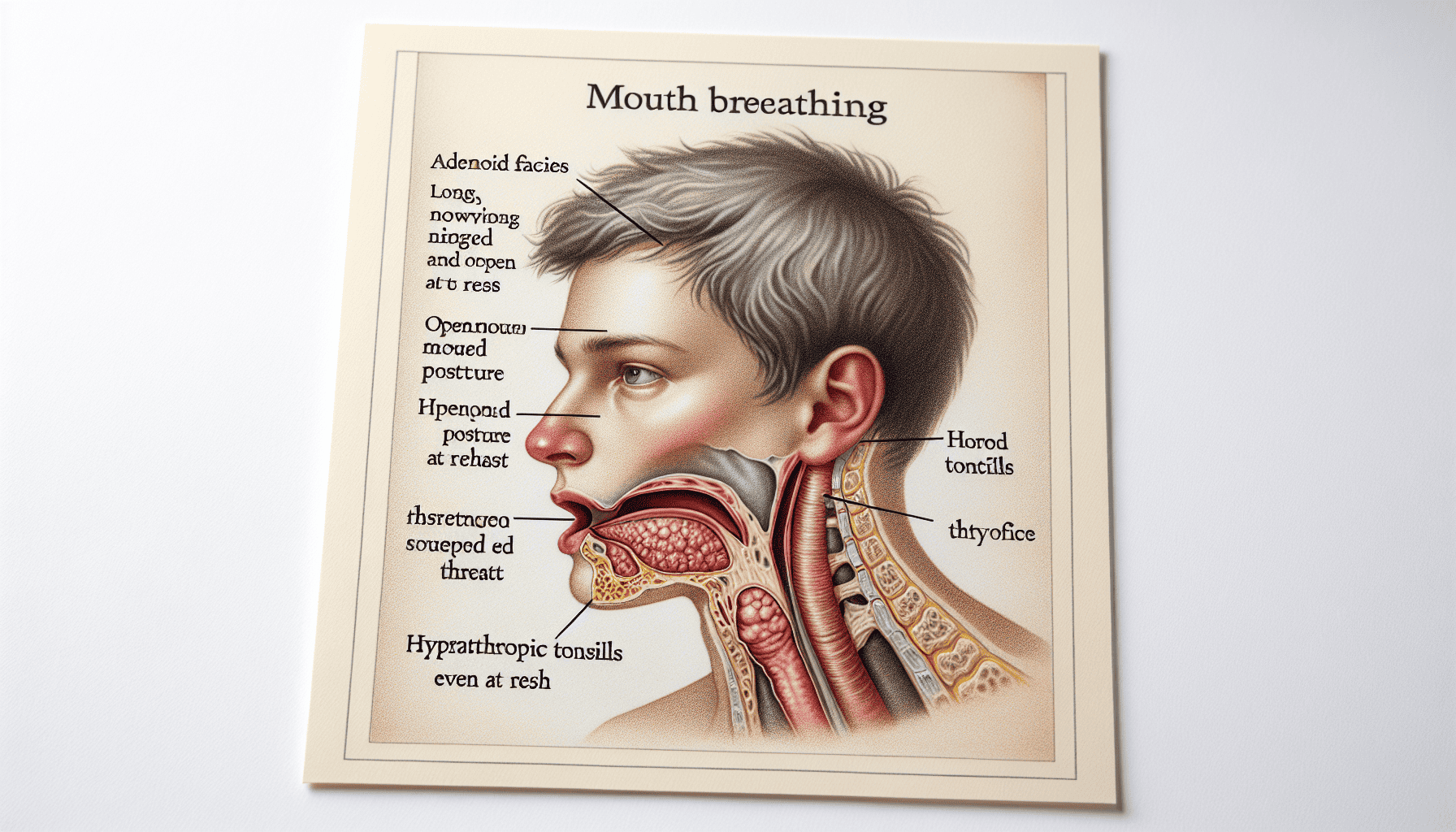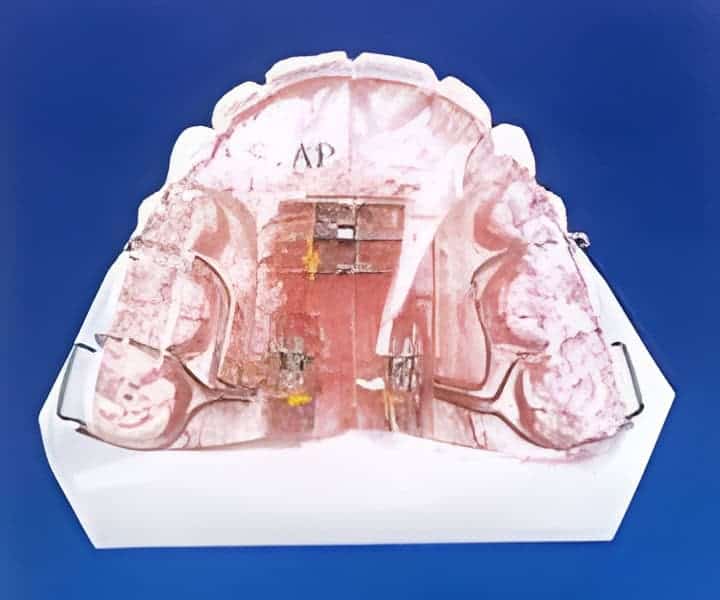Wondering, does mouth breathing change your face? Yes, it can. Chronic mouth breathing may alter facial development, with effects that are more pronounced in children but can also present in adults. This article sheds light on the modifications you might expect to see, the science behind them, and strategies to prevent or address these changes.
Mouth Breather at age 7 and nose breather at age 15

Key Takeaways
- Mouth breathing can lead to significant alterations in facial structure, including ‘long-face syndrome,’ impacting both aesthetics and physical development, with more significant effects on children than adults.
- Causes of mouth breathing range from small palate and tongue ties to temporary blockages in the nose due to colds, allergies and structural issues like a deviated nasal septum or enlarged tonsils and adenoids.
- Treatment options include orthodontic palatal expanders, myofunctional therapy to strengthen oral and facial muscles, lip and tongue tie releases and surgical procedures for severe cases to address the root causes and promote long-term nose breathing.
There are ways to stop mouth breathing and correct facial profile and jaw alignment with orthodontic expanders and myofunctional therapy. Contact us for a consultation to learn more.
How to Cure Mouth Breathing Video?
The Impact of Mouth Breathing on Facial Structure
When it comes to breathing, the route air takes can be more influential than you might think. Mouth breathing, a seemingly innocuous act, can cast a long shadow on facial structure. It’s a condition that can lead to a slew of alterations, such as elongated faces, narrow palates, and misaligned jaws. Habitual mouth breathers, active day and night, are likely to develop a characteristic ‘mouth breathing face.’ This change often results in a condition known as ‘long-face syndrome’. This chronic mouth breathing habit engraves its signature on the visage, underlining the urgency to correct it before it solidifies into a permanent feature.
Chronic mouth breathing doesn’t only affect facial muscles and structure cosmetically, it also disrupts the body’s natural growth and development processes. The lower anterior facial height can increase, and the facial muscles may adapt to this altered mode of breathing, further reinforcing the changes in the facial skeleton. It’s this profound impact that makes understanding, diagnosing, and ultimately, correcting mouth breathing an imperative pursuit.
Effects on Children
The impact of mouth breathing on children is even more significant. It can hinder the normal development of their face and teeth, causing:
- Malocclusion, a condition where the teeth become overcrowded or crooked due to jaw bone misalignment
- Alterations that might seem cosmetic at first glance, but can cascade into a series of health issues, including an increased risk of developing sleep apnea
- Influence on behavior, causing sleep disruptions that manifest as hyperactivity or moodiness
Timely intervention is vital since the effects of mouth breathing on children can be severe and sometimes irreversible. Considering that up to a quarter of children may engage in mouth breathing, the importance of early diagnosis and intervention cannot be overstated. It’s a health issue with both immediate and long-term implications, emphasizing the need for vigilance from parents and healthcare providers alike. How do you correct
Effects on Adults
Adults, too, are not immune to the changes wrought by mouth breathing. While the facial structure is more fixed in adulthood, the aesthetic and functional repercussions can be significant. A holistic approach to facial aesthetics for adults often involves enhancing facial harmony and restoring balance, which can boost self-confidence and overall health. In severe cases, such as with obstructive sleep apnea, maxillomandibular advancement surgery, which moves both jaws forward, can be a lifesaver, expanding the airway and significantly improving breathing quality.
While the alterations in adults may not be as noticeable or develop as quickly as in children, they are still significant. Adults who continually engage in mouth breathing may find that it’s not just their sleep that’s affected; it can also be their overall health, considered normal facial aesthetics, and even their emotional wellbeing. Addressing these issues holistically underscores the need to consider the full spectrum of the mouth breather’s experience.
Causes of Mouth Breathing
What propels someone to become a mouth breather? Often, it’s not a conscious choice but rather a response to blockages in the airway. A small mouth with inadequate tongue space and reverse jaw position can be a big problem. When the tongue is too close to the throat it partially blocks the airway, making it necessary to open the mouth. The mouth is a larger space than the noes. When the nose is blocked or there is a tongue obstruction, people will open the mouth because the mouth is a larger air intake than the nose.
Nasal blockages due to colds, flu, or allergies can force air intake through the mouth as a compensatory mechanism. Structural issues within the nasal cavity, like a deviated septum, can also impede airflow and nudge someone towards mouth breathing. Less commonly, nasal polyps, tumors, or genetic abnormalities can create obstructions that make mouth breathing a necessity rather than a choice. Over time, this can develop into a habitual behavior, especially during rest or sleep.
Identifying the root causes of mouth breathing is vital for managing the condition. Whether it’s a temporary blockage from a cold or a more significant structural issue, identifying the cause paves the way for effective treatment. It’s not merely about stopping the habit; it’s about correcting the underlying issues that lead to chronic mouth breathing. Physical conditions such as small jaws, nasal obstructions, large tonsils and adenoids can all be diagnosed with a CT scan called a cone beam CBCT. The TMJ Sleep and Breathe Center has a state of the art system onsite for proper mouth breathing diagnosis.

Some common causes of mouth breathing include:
- Nasal congestion or blockage
- Reverse jaw position and poor facial profile
- Enlarged tonsils or adenoids
- Tongue tie
- Deviated septum
- Allergies
- Chronic sinusitis
- Sleep apnea
- TMJ problems
By addressing these underlying causes, you can effectively manage and treat mouth breathing.
Nasal Obstruction
Nasal obstruction commonly triggers the habit of mouth breathing. An abnormal septum can hinder airflow and create a blocked nose, pushing someone to breathe through their mouth. In children, enlarged adenoids can obstruct the nasal passages, making mouth breathing a necessity. Such obstructions can lead to distinct facial changes, such as a more pronounced facial convexity and a deeper mentolabial sulcus, especially in children. Furthermore, nasal obstructions can alter the structure of the upper airway, making it prone to collapse during sleep, which is particularly problematic for mouth breathers.
When nasal passages are compromised, mouth breathing often becomes the default. This can set off a domino effect, impacting throat function, respiratory patterns, and even the development of the jaw and chin. Addressing nasal obstruction is pivotal in ensuring that both air and mouth remain closed during rest, fostering healthy breathing patterns and promoting a harmonious facial development.
Allergies and Chronic Colds
Allergies and chronic colds are another significant factor that can lead to mouth breathing. When the immune system reacts to allergens, nasal passages can become inflamed and congested, making nasal breathing a challenge and often leading to an open mouth to compensate for the lack of air. The same goes for chronic colds, which can cause nasal congestion and force individuals to adopt mouth breathing, especially during severe congestion. This can affect sleep quality, as the body struggles to maintain adequate oxygen levels through the night.
Addressing these health issues is key to preventing mouth breathing and its related complications. By managing allergies and colds effectively, individuals can keep their nasal passages clear and encourage nose breathing, which is crucial for maintaining good respiratory health and preventing the development of a mouth breathing habit.
Recognizing Mouth Breathing Symptoms
Identifying mouth breathing symptoms can be the initial step in managing this condition. Several symptoms can raise the red flag, such as:
- Sleep apnea
- ADHD-like behavior in kids
- A propensity to sleep with the mouth open
- A persistently dry mouth
- Drooling during sleep
- Nasal congestion
- An itchy nose
- Bed wetting in children
- Night terrors
Mouth breathers are also at risk of developing dental and health problems due to the dryness of the mouth, which can lead to bad breath and other dental issues, making mouth breathing bad for overall health. Waking up with a dry mouth or finding evidence of drooling on pillows are telltale signs of reliance on mouth breathing during sleep, often referred to as “mouth breath” episodes.
The symptoms of mouth breathing are not only uncomfortable but can also be indicative of other health concerns. Nasal congestion from allergies or chronic colds can exacerbate the problem, affecting sleep quality and leading to a host of issues that can impact daily life. Healthcare providers often link mouth breathing with sleep disorders and, in children, with learning difficulties and behavioral problems. Recognizing these symptoms is pivotal in seeking timely diagnosis and treatment.
Diagnosing Mouth Breathing Issues
A comprehensive evaluation to diagnose mouth breathing includes looking for signs like:
- Adenoid facies
- Enlarged tonsils
- A deviated nasal septum
- Restful open-mouth posture
It’s a comprehensive assessment that goes beyond identifying standalone signs, considering various characteristics that may be present. Healthcare providers, particularly dental professionals, play a crucial role in this process, using their expertise to identify the dental and facial indicators of mouth breathing.
The diagnosis is the linchpin in the treatment process, as it informs the direction of the interventions that will follow. By understanding the full extent of the issue, professionals can devise a personalized plan to address the mouth breathing habit and correct the underlying problems, whether they’re structural or behavioral.

Treatment Options for Mouth Breathing
Several treatment options are available once mouth breathing is diagnosed. Orthodontic treatments, myofunctional therapy, and surgical interventions are among the most effective options available. Each treatment type tackles the issue from a different angle, aiming to correct structural issues, strengthen oral and facial muscles, or remove anatomical blockages that impede proper breathing. The goal is not simply to stop mouth breathing but to promote long-term nasal breathing, ensuring that the mouth remains closed and the nasal passages are utilized for breathing.
The treatment chosen will depend on the root cause of the mouth breathing and the individual’s specific needs. A comprehensive approach often yields the best results, combining different treatment modalities to address both the physical and functional aspects of mouth breathing.

Orthodontic Treatments
Orthodontic treatments are essential in rectifying dental problems linked to mouth breathing, like malocclusion, misaligned teeth, and structural imbalances in the mouth’s bony structures. Appliances like Invisalign can improve mouth breathing by expanding the mouth and jaws, which aids in promoting proper nasal breathing. These treatments not only align the upper and lower teeth but also address a variety of dental problems, from chronic bad breath to gum disease, which are often associated with mouth breathing.
Orthodontic treatments can aid individuals in aligning their teeth and jaws, significantly influencing their breathing patterns. By fostering proper tongue placement and minimizing airway obstruction, these treatments can help ensure that the mouth stays closed during sleep, facilitating healthy nasal breathing.
Myofunctional Therapy
Myofunctional therapy, similar to physical therapy for tongue and facial muscles, addresses improper functions contributing to health issues such as mouth breathing. This therapy includes exercises that improve tongue placement, strengthen the tongue and facial muscles, and promote healthy breathing patterns. Regular practice of these exercises can alleviate abnormal tongue activity, potentially reducing the risk of periodontal disease, myofascial pain, and increased tooth mobility.
Myofunctional therapy offers advantages beyond just rectifying mouth breathing. By strengthening facial muscles and promoting correct breathing patterns, this form of therapy can significantly improve overall oral health and function. It’s a proactive approach that empowers individuals to take control of their respiratory and oral health, leading to lasting improvements.
Surgical Interventions
In some cases, surgical interventions may be necessary to address anatomical blockages that cause mouth breathing. Procedures that can provide relief for those with obstructed airways include:
- Adenoidectomy
- Tonsillectomy
- Correction of a deviated septum
- Trans Oral Robotic Surgery (TORS), a cutting-edge technique that allows surgeons to remove obstructive tissue from behind the tongue with a 3-D view, improving breathing in mouth breathers
- Uvulopalatopharyngoplasty (UPPP) and lateral pharyngoplasty, which widen the airway by reconfiguring or removing excess throat tissue.
For individuals with severe mouth breathing problems, these surgical procedures can be transformative. By enhancing the airway and reducing the risk of airway narrowing during sleep, surgeries can help people breathe more easily and reduce the health risks associated with mouth breathing. While surgery is typically considered a last resort, for some, it is the most effective way to achieve lasting relief from mouth breathing.
Prevention and Management Techniques
A comprehensive approach to prevent and manage mouth breathing includes:
- Breathing exercises such as Nadi Shodhana (alternate nostril breathing) and diaphragmatic breathing to retrain respiratory patterns away from mouth breathing
- Lifestyle modifications like reducing stress and elevating the head during sleep
- Interventions to maintain clear nasal passages
- Addressing underlying health concerns
- Using orthodontic expanders
- Engaging in myofunctional therapy
These strategies can effectively manage correct mouth breathing.
It’s about more than just stopping the habit; it’s about creating an environment that supports proper nasal breathing. By incorporating these prevention and management techniques into daily routines, individuals can protect their respiratory health and ensure that mouth breathing doesn’t become a chronic issue.
The Benefits of Proper Nasal Breathing
Nose breathing is not merely the standard practice; it’s a requirement for optimal health. Proper nasal breathing comes with a host of benefits, including reduced blood pressure, improved cardiovascular function, and a more relaxed state. By engaging in nasal breathing, individuals can influence their nervous system, shifting into a parasympathetic state associated with rest and digestion.
During rest, nasal breathing can lower the perceived rate of exertion and decrease diastolic blood pressure compared to mouth breathing.
The advantages of nasal breathing are clear, making it a goal worth striving for. By breathing through the nose, individuals can ensure they receive enough oxygen, maintain a healthy respiratory pattern, and enjoy the full range of health benefits that come with proper breathing.
Summary
In wrapping up, it’s evident that mouth breathing is more than a mere inconvenience; it’s a condition with profound implications for facial structure, dental health, and overall well-being. From the developmental impacts on children to the holistic treatment approaches for adults, understanding the causes, recognizing the symptoms, and exploring the treatment options are pivotal in managing this condition. With the right strategies in place, including orthodontic treatments, myofunctional therapy, and surgical interventions, individuals can transition from mouth breathing to proper nasal breathing, reaping the associated health benefits.
Frequently Asked Questions
What are the long-term effects of mouth breathing on children?
Mouth breathing in children can lead to malocclusion, altered facial development, an increased risk of sleep apnea, and behavioral and learning difficulties due to sleep disruptions.
Can mouth breathing in adults be reversed?
Yes, with treatments like orthodontic corrections, myofunctional therapy, and in severe cases, surgery, some effects of mouth breathing in adults can be reversed, improving respiratory health.
What are the most common causes of mouth breathing?
Chronic mouth breathing can develop due to nasal blockages from colds, allergies, or structural issues like a deviated septum, as well as habitual behavior.
How is mouth breathing diagnosed?
Mouth breathing is diagnosed through a comprehensive evaluation by a healthcare provider, which includes looking for signs like adenoid facies, hypertrophic tonsils, deviated nasal septum, and an open mouth posture at rest. It may also involve dental professionals.
What can be done to prevent mouth breathing?
To prevent mouth breathing, you can practice breathing exercises, maintain clear nasal passages, correct poor posture, manage allergies and colds, reduce stress, maintain good oral hygiene, and engage in regular physical activity. These strategies can help improve breathing habits and reduce the need for mouth breathing.
 703-712-1053
703-712-1053 